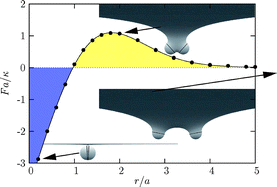Membrane-mediated interactions between circular particles in the strongly curved regime†
Abstract
Particles binding to a fluid

* Corresponding authors
a Max-Planck-Institute for Polymer Research, Ackermannweg 10, Mainz, Germany
b Carnegie Mellon University, Department of Physics, 5000 Forbes Ave., Pittsburgh, PA, USA
Particles binding to a fluid

 Please wait while we load your content...
Something went wrong. Try again?
Please wait while we load your content...
Something went wrong. Try again?
B. J. Reynwar and M. Deserno, Soft Matter, 2011, 7, 8567 DOI: 10.1039/C1SM05358B
To request permission to reproduce material from this article, please go to the Copyright Clearance Center request page.
If you are an author contributing to an RSC publication, you do not need to request permission provided correct acknowledgement is given.
If you are the author of this article, you do not need to request permission to reproduce figures and diagrams provided correct acknowledgement is given. If you want to reproduce the whole article in a third-party publication (excluding your thesis/dissertation for which permission is not required) please go to the Copyright Clearance Center request page.
Read more about how to correctly acknowledge RSC content.
 Fetching data from CrossRef.
Fetching data from CrossRef.
This may take some time to load.
Loading related content
